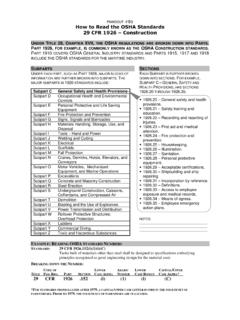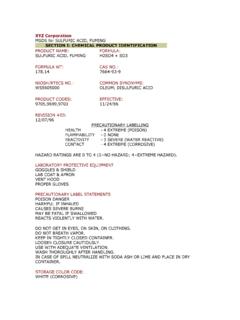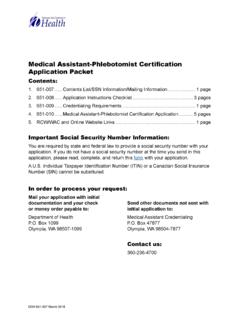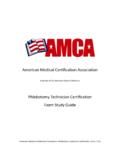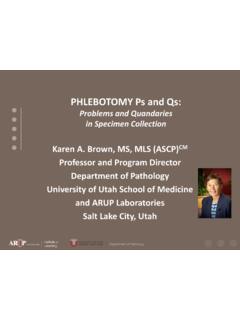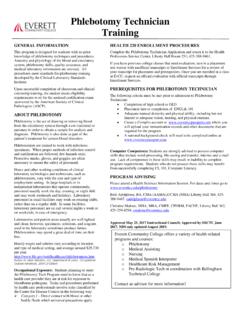Transcription of Lesson 01 Milestones in the Development of the Phlebotomy ...
1 Phlebotomy Technician | Lesson 1: Introduction to Phlebotomy 2014 All Rights Reserved. The Historical Development of the Phlebotomy Profession Milestones in the Development of the Phlebotomy Profession Although Phlebotomy is considered a modern-day health care profession, the roots of Phlebotomy are historically ancient and thoroughly fascinating. To begin this journey, let s first look closer at the actual word Phlebotomy . The medical term Phlebotomy comes from the Greek word parts phlebo- (blood vessels or vein) and -tomy (to cut into or to make an incision into). If we add -ist (a specialist or one who does) to the end of the word Phlebotomy and drop the -y, we create a new word, phlebotomist. A phlebotomist is the person who physically performs the blood draw, or venipuncture.
2 Venipuncture is an invasive procedure because entry into the human body is necessary to obtain the blood or body specimen. Primarily used for diagnostic purposes today, Phlebotomy is the most commonly executed invasive procedure found in modern health care. Phlebotomy to cut into or to make an incision into blood vessels or veins phlebotomist a person who practices Phlebotomy venipuncture technical name for a blood draw diagnostic used to determine the cause of an illness bloodletting removing blood to prevent or cure an illness Phlebotomy Technician | Lesson 1: Introduction to Phlebotomy 2014 All Rights Reserved. Phlebotomy in the Ancient World Venipuncture was regularly used in history to implement a treatment known as bloodletting (removing blood to prevent or cure an illness).
3 The intention of bloodletting was much different from that of modern Phlebotomy . Bloodletting employed venipuncture as a therapy for illness, not as a diagnostic tool to determine the cause of illness. The art of bloodletting can be traced back in human history at least 2,500 years and was not limited to any one particular culture or geographical location. It seems that the act of draining a person s blood to encourage healing and wellness was a globally recognized and acceptable procedure. It is documented in hieroglyphic drawings found in ancient Egypt, Ayurvedic writings of East India, the Persian Canon of Medicine, and in many sacred passages such as found in the Talmud, and the Bible. Historic Tools for Phlebotomy A wide variety of tools were implemented over the centuries to procure red gold, or blood.
4 In the Mayan society, shark s teeth, stingray spines, ropes made with thorns, sharpened bones, and obsidian blades were used to pierce a person s flesh. Fire cupping has been used by many cultures to pull blood from the body by creating a vacuum seal between the skin and the lip of a wooden or glass cup that has been heated. As the vacuum strength increases inside the attached cup, so does the power of extraction. Lancets and fleams were typically forged from metal. Some lancets were spring-loaded and retractable the blade would return to a protective sheath once the skin was punctured. Fleams often had double-sided wide blades that sat at 90-degree angles to the handle. Scarificators had a trigger release system that caused 12 rotary blades to make multiple shallow incisions into the skin s surface.
5 Bleeding bowls collected blood released during a bloodletting procedure. They were made Vacuum Cup Pulling Blood to the Surface of the Skin Phlebotomy Technician | Lesson 1: Introduction to Phlebotomy 2014 All Rights Reserved. with a variety of materials, from turtle shells to bronze. Some bowls had marks on the inside, signifying that once the blood had reached that level, the practitioner needed to compress the wound and stop the bleeding. Of all the devices used for bloodletting, one in particular can make even a strong person squirm: leeches. This much-despised tiny worm attaches itself to unaware swimmers to get a light snack of blood. Its use in bloodletting also has deep roots in medical history. Leech therapy has become very popular once again in modern medicine.
6 The leech that is most commonly used is called Hirudo medicinalis. Leeches have been known to ingest up to ten times their own body weight in blood. The intent of using Hirudo medicinalis is to reduce inflammation in a localized body area by allowing the leeches to drain blood and excessive fluids from the diseased area. Leech therapy has become very popular once again in modern medicine to reduce inflammation in a localized body area by allowing the leeches to drain blood and excessive fluids from the diseased area. Notable Names in the Early Development of Phlebotomy Many famous names in history are associated with the progression of venipuncture from ancient days to modern Phlebotomy . You may have heard the name Hippocrates (460 377 BC), who is also called the Greek father of modern medicine.
7 Hippocrates believed that maintaining balance in the body was vital to good health. He developed a theory that there were four humors of the body: yellow bile (choleric yellow bilirubin fire) black bile (melancholic brown with clotting agents and platelets earth) phlegm (phlegmatic clear plasma water) Hippocrates (460 377 BC) Leech Sucking Blood from a Leg Phlebotomy Technician | Lesson 1: Introduction to Phlebotomy 2014 All Rights Reserved. blood (sanguine rich with red hemoglobin air) Each of these humors is associated with specific organs which, if properly regulated, keep the body in balance. Known as the surgeon of the gladiators, Galen of Pergamum (129 201 AD) made a bold statement declaring that blood was the strongest of all the bodies humors.
8 He was a prolific writer, exceeding two million documented words, and advocated bloodletting. He greatly influenced the Development of scientific study and the sciences of neurology, pathology, pharmacology, anatomy, and physiology. The Guild of Barber-Surgeons was established in 1210. Barber-surgeons were set apart from standard surgeons by the length of their robes. Barber-surgeons were required to wear short robes, which distinguished them as limited practice surgeons. They were only allowed to perform enemas, tooth extractions, bloodletting, cupping, leeching, wound repair, and shaving. These practitioners would make their presence known by placing a pole outside their shops on which long bandages could dry. In the familiar striped barber pole, the red represents blood and the white represents clean bandages.
9 The pole itself signified the tool that a patient would grab to promote blood flow, and often there would be a bleeding bowl hanging from the bottom of the pole. Author of the seven-volume collection De Humani Corporis Fabrica (On the Fabric of the Human Body), Andreas Vesalius (1514 1564) rocked the medical world and became known as the founder of modern human anatomy. In 1539, Vesalius wrote Venesection, which supported and detailed the art of bloodletting. William Harvey (1578 1657) published De Motu Cordis (On the Motion of the Heart and Blood in Animals). What made this publication unique was Harvey s advanced use of the scientific method. He showed that blood does not simply slosh around in vessels within the body; instead, blood has a designated route of flow throughout the body.
10 This route Heart, Arteries, and Veins Medieval Barber's Pole in Winchester, England Phlebotomy Technician | Lesson 1: Introduction to Phlebotomy 2014 All Rights Reserved. focused on the heart pumping oxygen-rich blood through arteries and the blood returning to the heart through veins. French physician Jean-Baptiste Denis (also spelled Denys) lived from 1643 to 1704. He served as royal physician to Louis XIV and made his mark on history by performing the first recorded human blood transfusion on June 15, 1667. A 15-year-old boy had undergone an excessive bloodletting process with leeches. Denis transfused 12 ounces of sheep s blood into the young man, who survived the procedure, thus paving the way for modern blood transfusions. James Blundell (1791 1878) is noted for performing the first human-to-human blood transfusion.
